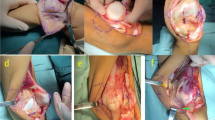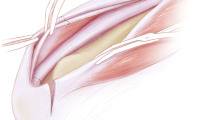Abstract
Purpose
Treatment of congenital knee dislocation (CDK) depends on the severity and flexibility of the deformity. Various modalities of treatment ranging from serial cast, open quadricepsplasty and minimally invasive quadricepsplasty have been described. We describe percutaneous needle quadriceps tenotomy for treatment of flexible CDK and present our result of retrospective case series.
Methods
This was a retrospective study of 12 patients (20 knees) with flexible CDK. Eight patients with bilateral and four with unilateral deformities. The mean age of intervention was 14.5 days (range, 4–55 days). None of the patients were syndromic. All procedures were done within eight weeks of age. The outcome was measured using knee evaluation score and complications in view of extensor lag, instability and knee flexion deformity. Ultrasound was performed to check for integrity of quadriceps mechanism.
Results
The mean pre-operative hyperextension was 50° (range, 30–70°). All patients were able to achieve >90° flexion intra-operatively. The mean knee flexion at walking age was 135° (range, 130–140°). Knee evaluation score showed good results in nine patients and fair result in three patients. There was no extensor lag, knee flexion deformity or infection. One patient of anterior instability had ACL aplasia which was documented on MRI. Ultrasound performed at walking age showed normal functioning of quadriceps mechanism.
Conclusions
Percutaneous needle tenotomy of quadriceps is a effective, simple and safe procedure for flexible, non syndromic CDK presenting early. It avoids complications associated with the open surgical procedure and causes less extensor scarring. However its effectiveness in stiff/hyperlax variants associated with syndromes is yet to be determined.



Similar content being viewed by others
References
Fernández-Palazzi F, Silva JR (1990) Congenital dislocation of the knee. Int Orthop 14(1):17–19
Kettelkamp DB, Thompson C (1975) Development of a knee scoring scale. Clin Orthop Relat Res 107:93–99
Jacobsen K, Vopalecky F (1985) Congenital dislocation of the knee. Acta Orthop Scand 56(1):1–7
Yalaburgi SB (1981) Congenital dislocation of the knee. A report of 5 cases. S Afr Med J 59(22):804–806
Ooishi T, Sugioka Y, Matsumoto S, Fujii T (1993) Congenital dislocation of the knee. Its pathologic features and treatment. Clin Orthop Relat Res 287:187–192
Oetgen ME, Walick KS, Tulchin K, Karol LA, Johnston CE (2010) Functional results after surgical treatment for congenital knee dislocation. J Pediatr Orthop 30(3):216–223
Weiss SM, Brooks DB (1977) A simplified method of splinting for congenital dislocation of the knee. Clin Orthop Relat Res 123:40–41
Johnson E, Audell R, Oppenheim WL (1987) Congenital dislocation of the knee. J Pediatr Orthop 7(2):194–200
Shah NR, Limpaphayom N, Dobbs MB (2009) A minimally invasive treatment protocol for the congenital dislocation of the knee. J Pediatr Orthop 29(7):720–725
Roy DR, Crawford AH (1989) Percutaneous quadriceps recession: a technique for management of congenital hyperextension deformities of the knee in the neonate. J Pediatr Orthop 9(6):717–719
Minkowitz B, Finkelstein BI, Bleicher M (2004) Percutaneous tendo-Achilles lengthening with a large-gauge needle: a modificationof the Ponseti technique for correction of idiopathic clubfoot. J Foot Ankle Surg 43(4):263–265
Patwardhan S, Shyam AK, Sancheti P (2012) Percutaneous needle tenotomy for tendo-achillis release in cases of clubfoot – technical note. J Ortho Case Rep 2(1):35–36
El Hage S, Rachkidi R, Noun Z, Haidar R, Dagher F, Kharrat K, Ghanem I (2010) Is percutaneous adductor tenotomy as effective and safe as the open procedure? J Pediatr Orthop 30(5):485–488
Bain GI, Turnbull J, Charles MN, Roth JH, Richards RS (1995) Percutaneous A1 pulley release: a cadaveric study. J Hand Surg [Am] 20:781–784
Patwardhan S, Shyam AK (2012) Use of percutaneous needle tenotomy for treatment of congenital knee dislocation—technical note. J Ortho Case Rep 2(3):25–27
Laurence M (1967) Genu recurvatum congenitum. J Bone Joint Surg (Br) 49(1):121–134
Abdelaziz TH, Samir S (2011) Congenital dislocation of the knee: a protocol for management based on degree of knee flexion. J Child Orthop 5(2):143–149
Sud A, Chaudhry A, Mehtani A, Tiwari A, Sharma D (2009) Functional outcome following quadriceps tendon lengthening in congenital dislocation of the knee, with special reference to extensor weakness. Strateg Trauma Limb Reconstr 4(3):123–127
Bianchi S, Zwass A, Abdelwahab IF, Banderali A (1994) Diagnosis of tears of the quadriceps tendon of the knee: value of sonography. AJR Am J Roentgenol 162(5):1137–1140
Mangat KS, Kanwar R, Johnson K, Korah G, Prem H (2010) Ultrasonographic phases in gap healing following Ponseti-type Achilles tenotomy. J Bone Joint Surg Am 92(6):1462–1467
Maranho DA, Nogueira-Barbosa MH, Simão MN, Volpon JB (2009) Ultrasonographic evaluation of Achilles tendon repair after percutaneous sectioning for the correction of congenital clubfoot residual equinus. J Pediatr Orthop 29(7):804–810
Ingraham JM, Hauck RM, Ehrlich HP (2003) Is the tendon embryogenesisprocess resurrected during tendon healing? Plast Reconstr Surg 112:844–854
Conflict of interest
None.
Author information
Authors and Affiliations
Corresponding author
Rights and permissions
About this article
Cite this article
Patwardhan, S., Shah, K., Shyam, A. et al. Assessment of clinical outcome of percutaneous needle quadriceps tenotomy in the treatment of congenital knee dislocation. International Orthopaedics (SICOT) 39, 1587–1592 (2015). https://doi.org/10.1007/s00264-015-2806-7
Received:
Accepted:
Published:
Issue Date:
DOI: https://doi.org/10.1007/s00264-015-2806-7




